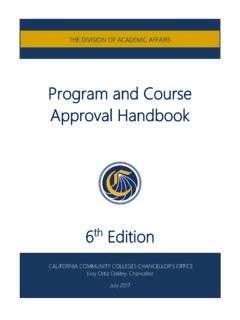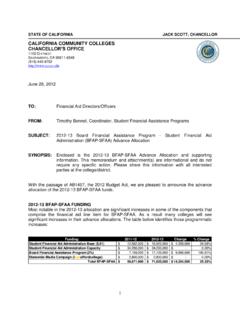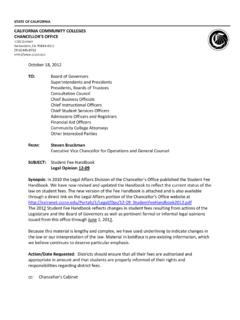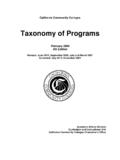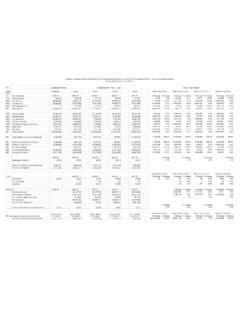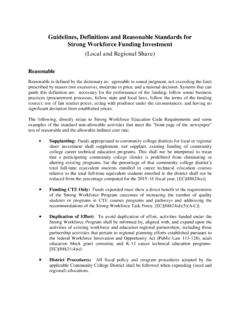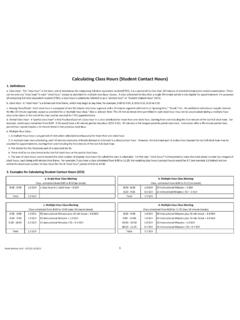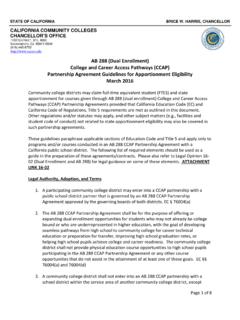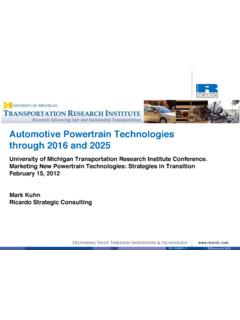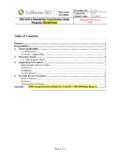Transcription of Standards, Evaluation Criteria and Best Practices
1 Appendix D Standards, Evaluation Criteria and Best Practices Telecommunications and Technology Advisory Committee Systemwide Architecture Committee APPENDIX D STANDARDS, Evaluation Criteria , AND BEST Practices From the Telecommunications and Technology Advisory Committee And Systemwide Architecture Committee DEFINITIONS Key terms and acronyms pertaining to the california Community College environment are explained below. CalREN california Research and Educational Network a network linking CSUs, UCs, CCCs, and some private colleges in california to a common backbone with access to the Internet CCCCO california Community Colleges Chancellor s Office CCCs california Community Colleges commonly used Referring to hardware and software components that are in common use in industry ( having a significant market share) or within the community college system (as identified in the technology survey located on the CISOA website: ) CSU california State University ERP Enterprise Resource Planning administrative information systems used to automate administrative processes and manage record keeping at colleges feasibility study A feasibility study is designed to provide an overview of the primary issues related to a technology project.
2 The purpose is to identify any make or break issues that would prevent the project from being successful in meeting requirements and goals of the project. In other words, a feasibility study determines whether the technical approach makes sense. A feasibility study will include an Evaluation of alternative approaches and rationale why the selected systems were chosen. project A human endeavor, involving a team of personnel, plans, actions, and outcomes, which are directed at developing and / or maintaining an information technology based system to achieve a set of goals, within a specified timeline, and within budget SAC System wide Architecture Committee system The specific configuration of software, hardware, network components, and associated human processes, which is developed and implemented to support the achievement of project goals UC University of california Appendix D 2 Evaluation Criteria 1. Feasibility Study Has a feasibility study been conducted?
3 Have system components been chosen that are consistent with the recommendations of the feasibility study? Does the feasibility study recommend project continuation? 2. Suitability for systemwide deployment: Is the concept scalable for systemwide implementation? Is the technical concept easy to implement and support by districts (low cost, use of common technical skills)? If appropriate, does the technical approach allow easy integration with commonly-in-use ERP systems and other technologies at CCCs 3. Life cycle plan for components Do each of the system components (hardware and software) have an expected lifespan (through a support, maintenance, and replacement plan) to meet the requirements and objectives for the project. The support plan should break the system down into individual component parts and describe how each of the components (and associated maintenance approaches / service level agreements) supports the system lifecycle. 4.
4 Goals versus functionality What is the variance between project goals and the performance of the project for the timeframe and phase under consideration ( does the functionality of the system meet project objectives)? Use goals from project documentation or as modified, from the project monitor. 5. Adherence to published standards Do each of the system components meet the minimum level of technical standards specified by SAC? Appendix D 3 Identify and describe variances along with rationale for not adhering to standards. 6. Exposure to risk Describe any areas of significant risk exposure for this project. Overall technical approach (Leading edge bleeding edge obsolete) System components (maturity, proprietary, vendor organization stability) User interface issues and willingness to adopt Schedule Budget Performance Data security Recovery from system failure Ownership of source code 7. Outsourcing Is it more cost-effective to outsource than to develop and / or maintain within the CCC system?
5 Should consider both cost savings and other advantages Can the CCC system effectively develop and maintain the technical system without outsourcing? Consider helpdesk requirements 7x24 What is the risk to the primary mission of the CCC system if potential outsourcing vendor(s) experience bankruptcy, leave the business, or cutback resources rendering the outsourced system non-functional? What phases of the project are appropriate for outsourcing? Development versus ongoing (maintenance) projects should use different Criteria when examining the outsourcing question. Appendix D 4 Bleeding edge projects may have resource needs that are better served through outsourcing. 8. Funding and resource support Are the funding and resources adequate to achieve the stated technical goals of the project according to the timeline for the project? Consider all phases of the project lifecycle that are funded Does the project have a comprehensive Service Level Agreement (SLA) in place with users?
6 Standards 1. A technology feasibility study must be conducted before significant project funds are committed to determine the suitability of the selected technical approach (configuration, choice of components, etc.) to meeting the requirements, budget, and timeline constraints of the project. 2. Data transfer A. All applications will include the ability to import and export information (as appropriate) that is stored in databases to known, commonly used formats. Delimited files (comma, tab, fixed length) EDI (as appropriate) IMS (as appropriate) XML B. The LAN / WAN (linking to CalREN or other Internet access point as appropriate) will provide sufficient bandwidth to manage the volume of expected transactions. If the project has a requirement for a software application that will manage high volume transactions, then the project manager must conduct an Evaluation of expected traffic volume (in transactions per second or other appropriate measure) and determine bandwidth requirements.
7 Appendix D 5 C. Digital data communications must support all of the following transport mechanisms and protocols: Ethernet IP ODBC 3. System (Application, Hardware, Network Operating Systems, etc.) A. The system will have capability to be easily ported to other sites (CCCCO, CCCs, or other organizations) for operations and support. B. The system will be developed with and maintained using commonly used components and tools. C. The choice of system components will meet project objectives and stay within the availability of project funds. D. The system will have a support plan that is adequate to meet project objectives for the expected life of the system. E. System components will be compatible with the existing and planned CCC information technology environment and infrastructure. F. The system will be compatible with existing technology environments at districts and colleges including ERP systems and courseware.
8 G. If applicable and appropriate, the project manager must provide the capability to collect data on actual: Transactions per second Number of hits to the web portal User dwell time or time spent on line in an application 4. End user compatibility A. Software applications will be compatible with the current version and one major version behind of the Microsoft operating system (on user computing platforms). B. The data for the presentation of information to users (of Internet browsers) must be conveyed to users in HTML format in addition to any other advanced formats that are provided C. The system will conform to regulations that are specified by Section 508 of the Rehabilitation Act, Section 11135 of the california Government Code, Appendix D 6 and applicable CCCCO regulations. Documentation of conformance shall be accomplished using the Voluntary Product Accessibility Template (VPAT) template and process, which can be found at: 5.
9 Databases and DBMS A. The project manager must publish a DED, which supports the schema of the database(s) used in the system B. The database (schema, data, embedded business rules, data validation rules) will have capability to be easily ported to other commonly used DBMS. C. All data contained within a database shall be validated to the data definition in the DED upon entry D. The DBMS must be ANSI SQL compliant. E. The DBMS must be accessible via ODBC by query, reporting, and development tools. F. The DBMS must have security locking down to table and row levels G. The DBMS must possess and use native encryption for storing confidential information 6. Query and Report Writing Tools A. The query or report writing tool(s) used within the system must have capability to pass ANSI SQL statements to the DBMS or other backend systems be commonly used within the CCC system be ODBC compliant 7.
10 Security A. Individually identifiable information and other forms of private data that are handled by the system (storing, accessing and transmitting) must be managed for compliance with Federal, state, and CCCCO privacy regulations (such as FERPA and AB1950). B. Unencrypted private data will not be transmitted unencrypted. Appendix D 7 C. Access to private data will be managed through secure portals D. Electronic or digital signatures will conform to standards that are developed by the Digital Signature Project, CCCCO regulations, and applicable legal rulings. 8. System configuration and operating procedures shall be documented in a sufficient manner to allow a community college to install, configure, operate and maintain the system and its functions (even if the system is planned to be outsourced to an application service provider.) 9. Vendor provided systems and components A. Vendor provided systems will comply with the same set of standards as above unless SAC recommends deviations.
